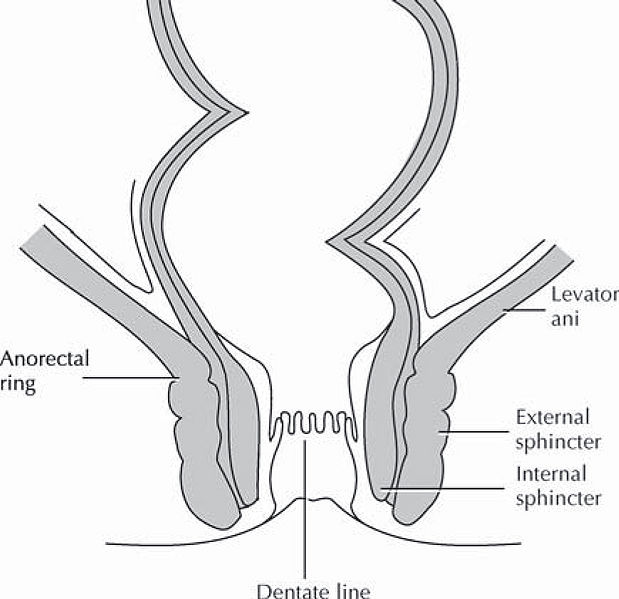Anal fissure pathophysiology: Difference between revisions
| Line 27: | Line 27: | ||
*Although constipation or anal trauma was supposed to instigate the fissure,the exact pathogenesis of anal fissure is not fully understood.<ref name="pmid22379402">{{cite journal |vauthors=Zaghiyan KN, Fleshner P |title=Anal fissure |journal=Clin Colon Rectal Surg |volume=24 |issue=1 |pages=22–30 |year=2011 |pmid=22379402 |pmc=3140330 |doi=10.1055/s-0031-1272820 |url=}}</ref> | *Although constipation or anal trauma was supposed to instigate the fissure,the exact pathogenesis of anal fissure is not fully understood.<ref name="pmid22379402">{{cite journal |vauthors=Zaghiyan KN, Fleshner P |title=Anal fissure |journal=Clin Colon Rectal Surg |volume=24 |issue=1 |pages=22–30 |year=2011 |pmid=22379402 |pmc=3140330 |doi=10.1055/s-0031-1272820 |url=}}</ref> | ||
*It is understood that anal fissure is the result of either anal trauma (by hard stools/diarrhea), perfusion defects with ischemia caused due to increased anal pressures and decreased blood flow or increased anal sphincter tone. | *It is understood that anal fissure is the result of either anal trauma (by hard stools/diarrhea), perfusion defects with ischemia caused due to increased anal pressures and decreased blood flow or increased anal sphincter tone. | ||
*In 90% of the patients, anal fissures are found in posterior midline. This is believed due to ischemia/poor perfusion of the area by inferior rectal artery.(during increased sphincter tone)<ref name="pmid2910660">{{cite journal |vauthors=Klosterhalfen B, Vogel P, Rixen H, Mittermayer C |title=Topography of the inferior rectal artery: a possible cause of chronic, primary anal fissure |journal=Dis. Colon Rectum |volume=32 |issue=1 |pages=43–52 |year=1989 |pmid=2910660 |doi= |url=}}</ref> | *In 90% of the patients, anal fissures are found in posterior midline. This is believed due to ischemia/poor perfusion of the area by inferior rectal artery.(during increased sphincter tone)<ref name="pmid2910660">{{cite journal |vauthors=Klosterhalfen B, Vogel P, Rixen H, Mittermayer C |title=Topography of the inferior rectal artery: a possible cause of chronic, primary anal fissure |journal=Dis. Colon Rectum |volume=32 |issue=1 |pages=43–52 |year=1989 |pmid=2910660 |doi= |url=}}</ref><ref name="pmid8653368">{{cite journal |vauthors=Schouten WR, Briel JW, Auwerda JJ, De Graaf EJ |title=Ischaemic nature of anal fissure |journal=Br J Surg |volume=83 |issue=1 |pages=63–5 |year=1996 |pmid=8653368 |doi= |url=}}</ref> | ||
==Associated Conditions== | ==Associated Conditions== | ||
Revision as of 19:12, 24 January 2018
|
Anal fissure Microchapters |
|
Diagnosis |
|---|
|
Treatment |
|
Case Studies |
|
Anal fissure pathophysiology On the Web |
|
American Roentgen Ray Society Images of Anal fissure pathophysiology |
|
Risk calculators and risk factors for Anal fissure pathophysiology |
Editor-In-Chief: C. Michael Gibson, M.S., M.D. [1];Associate Editor(s)-in-Chief: Amandeep Singh M.D.[2]
Overview
The exact pathogenesis of anal fissure is not fully understood. It is thought that anal fissure is the result of / is mediated by / is produced by / is caused by either [hypothesis 1], [hypothesis 2], or [hypothesis 3].
OR
[Pathogen name] is usually transmitted via the [transmission route] route to the human host.
anal fissure arises from [cell name]s, which are [cell type] cells that are normally involved in [function of cells].
OR
The progression to anal fissure usually involves the [molecular pathway].
OR
The pathophysiology of [disease/malignancy] depends on the histological subtype.
Pathophysiology

An anal fissure is a linear tear or superficial ulcer of the anal canal, extending from just below the dentate line to the anal margin.
Pathogenesis
- Although constipation or anal trauma was supposed to instigate the fissure,the exact pathogenesis of anal fissure is not fully understood.[2]
- It is understood that anal fissure is the result of either anal trauma (by hard stools/diarrhea), perfusion defects with ischemia caused due to increased anal pressures and decreased blood flow or increased anal sphincter tone.
- In 90% of the patients, anal fissures are found in posterior midline. This is believed due to ischemia/poor perfusion of the area by inferior rectal artery.(during increased sphincter tone)[3][4]
Associated Conditions
- Crohn's disease
- Syphilis
- HIV/AIDS
- Previous anal surgery
- Anal cancer
- Tuberculosis
Gross Pathology
- On gross pathology, [feature1], [feature2], and [feature3] are characteristic findings of anal fissure.
Microscopic Pathology
- On microscopic histopathological analysis, the following are characteristic findings of anal fissure:
- Prescence of fibrosis at the base of the fissure when compared to normal internal anal sphincter.[5]
References
- ↑ Source=http://www.surgwiki.com/wiki/File:Ch31-fig1.jpg
- ↑ Zaghiyan KN, Fleshner P (2011). "Anal fissure". Clin Colon Rectal Surg. 24 (1): 22–30. doi:10.1055/s-0031-1272820. PMC 3140330. PMID 22379402.
- ↑ Klosterhalfen B, Vogel P, Rixen H, Mittermayer C (1989). "Topography of the inferior rectal artery: a possible cause of chronic, primary anal fissure". Dis. Colon Rectum. 32 (1): 43–52. PMID 2910660.
- ↑ Schouten WR, Briel JW, Auwerda JJ, De Graaf EJ (1996). "Ischaemic nature of anal fissure". Br J Surg. 83 (1): 63–5. PMID 8653368.
- ↑ Brown AC, Sumfest JM, Rozwadowski JV (1989). "Histopathology of the internal anal sphincter in chronic anal fissure". Dis. Colon Rectum. 32 (8): 680–3. PMID 2752854.